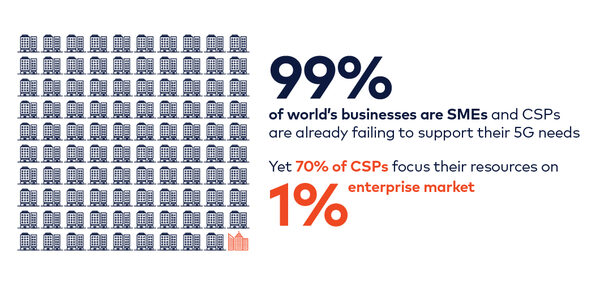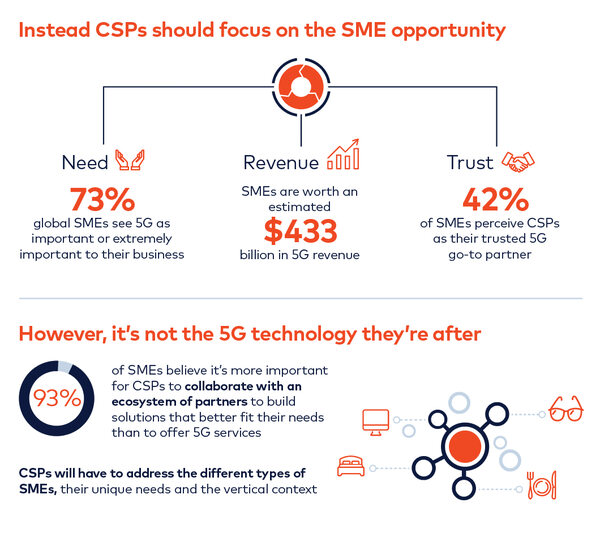
Small and medium-sized enterprises (SMEs) is possibly the last market segment that represents a sizeable revenue opportunity for Communications Service Providers (CSPs) in saturated markets. According to Omdia, SMEs represent 99% of the world’s businesses and are estimated to be worth $433 billion by 2025. They remain a vast and untapped market with the majority of CSPs focusing 70% of their resources on the 1% enterprise market. This was not a surprise for us.

Our 2020 report, B2B is the ‘North Star’ for 5G revenues: how do CSPs get there? recognized that CSPs were missing out on this significant opportunity. It highlighted that on average, 73% of global SMEs see 5G as important to their business. With this knowledge, we knew we needed to dig deeper to help solve the disconnect between the needs of SMEs, and CSPs’ perception of how to make the 5G opportunity bear fruit. It was at that point that we decided to collaborate with analyst firm Omdia.
We commissioned a series of reports that would ultimately give valuable insight into the potential of the B2B 5G opportunity for CSPs, and also the challenges they face to make it a reality. This week, we are launching our report – 5G for SMEs: what does it mean for CSPs? – where we dive a bit deeper and examine the SME appetite for 5G: where opportunities lie, how CSPs can add more value for 5G B2B solutions, and what role CSPs will need to play in the ecosystem to succeed. Here is what we found out:

1. SMEs trust CSPs more than Enterprises – many SMEs already see value in 5G and perceive CSPs as their trusted 5G go-to partner with 42% prioritizing them to execute their 5G strategies.
2. SMEs’ business needs can be as complex as large enterprises – an SME is a diverse and multi-faceted organization. Understanding its complex needs and vertical context is key.
3. Digitalization and COVID-19 have transformed the needs and urgency of SMEs and their awareness of the impact that new technologies such as 5G, IoT, and AI can have on their business to enhance productivity and efficiency, and boost sales.
4. However, it’s not 5G technology that they’re after – instead SMEs understand that 5G is one part of a broader technology solution that they need. 93% of SMEs told us that it’s more important for CSPs to collaborate with an ecosystem of partners to build solutions that better fit their needs, rather than just sell them 5G services.
We’re looking at a new type of SME, one that is seeking a partner that will orchestrate comprehensive partner ecosystems to co-create better solutions. For CSPs, this is a unique opportunity, especially considering SMEs see them as a strong candidate to fulfil this role. However, to realize this opportunity, CSPs will have to address the different types of SMEs out there, their unique needs and the vertical context.
This will mean gradually developing a growing number of solutions with an increasing number of technology partners and vertical specialists. Through the work we have done with CSPs we’ve deduced that building a 5G digital marketplace for SMEs, is the best solution to create these multi-partner solutions, while also simplifying the complexity for the SME user. This marketplace needs to allow CSPs the speed, repetition, automation and the scale to grow from selling a few SME solutions, to selling multiple solutions as more partners and customers come on board.
CSPs need to look at these marketplaces as the core engine to facilitate the adoption of new business models. On the one hand they need to better support the evolving needs of the user, but on the other hand also give them the calibre and the recurring revenue that they desperately need to maintain growth. Doing it right will also cement their central role in the emerging value chain.
The concept of a digital marketplace for SMEs is not new to CSPs. It’s a solution that’s been tested, not with great success, in the past, but a 5G digital marketplace should be different. It should be based on the principle of partners, not vendors, meaning different technology and vertical players collaborating with the CSPs to design and co-create solutions together.
These solutions should be pre-integrated and very simple for the SMEs to buy and use. So far, many of the Digital Marketplaces out there have acted more like an App-store, where you buy the applications or devices from a single provider and it was then up to the SME to assemble what it needed.
However, it’s clear that SMEs don’t have the knowledge nor the manpower to effectively manage this process themselves. Instead, it should be up to the CSPs to pre-integrate the pieces and offer an E2E solution to SMEs (smart retail, smart building etc.) hiding the complexity behind the scenes – including connectivity, devices, cloud, security, data, AI, edge and more. Using a 5G digital marketplace will automate the orchestration and the monetization of these multi-partner solutions, while also simplifying the complexity for the SME user.
We’re already seeing some CSPs take on the challenge to address this 5G SME gap by orchestrating a partner ecosystem. According to Omdia, Vodafone Spain offers an all-inclusive value proposition providing SMEs with compelling mobile-first productivity tools. In addition, SK Telecom is partnering with the Korea Smart Factory Data Association and software developer, BISTel, to offer a 5G-based big data analysis service to manufacturing SMEs.
These types of collaborative approaches demonstrate how CSPs can marry 5G capabilities and other assets with ecosystem players to deliver profound value to SMEs in 2021 and beyond. This opportunity to help SMEs reinvent their business models and grow at scale will be deeply transformational.
